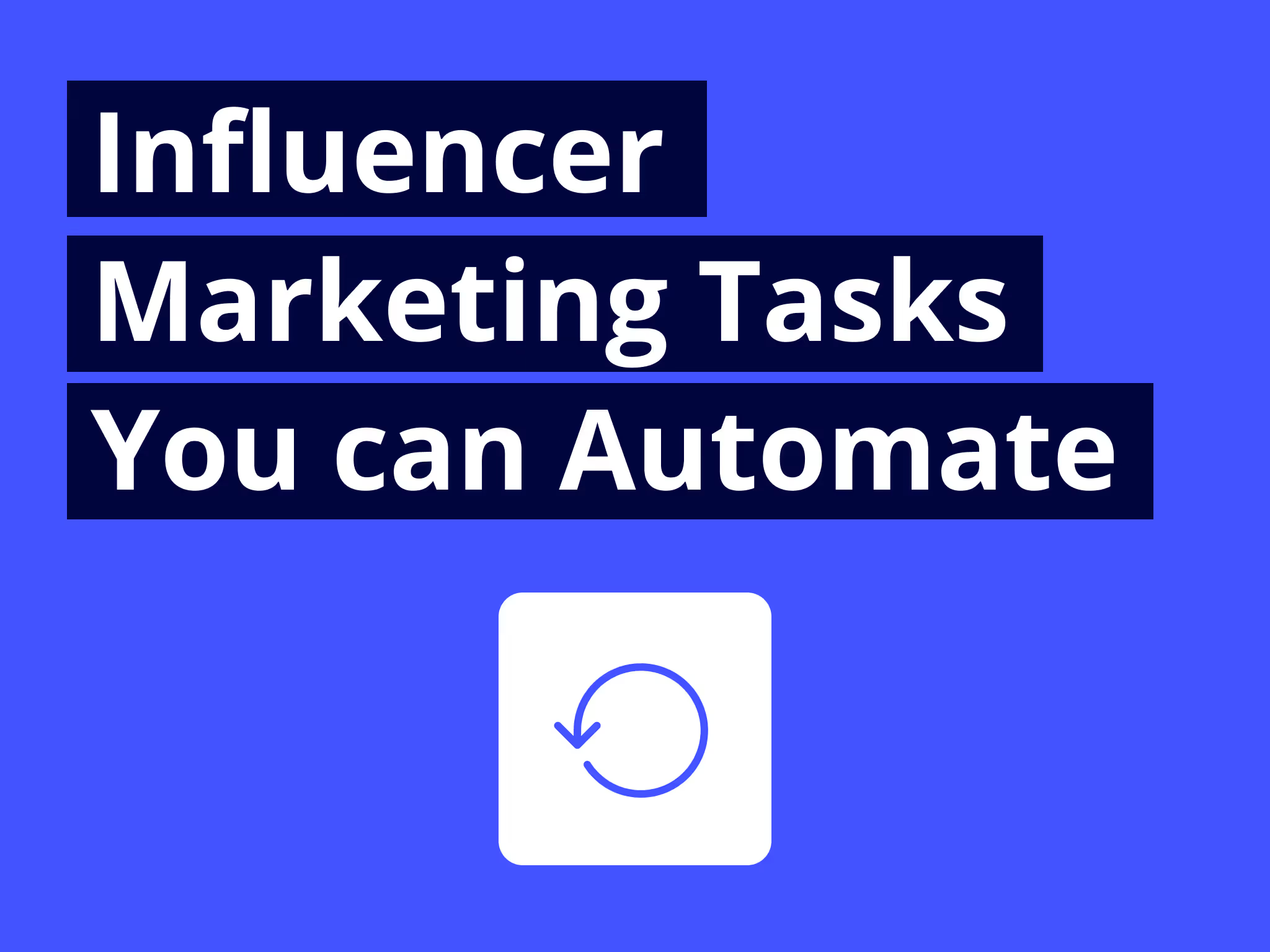Running successful influencer marketing campaigns is all about building meaningful relationships with your creator partners.
When it comes time to scale, influencer marketers know that adding automation to their daily workflow is a necessary step.
And yet plenty of influencer marketers worry about how automation will negatively impact the relationships they’ve built with their creator partners: too little automation, and you’ll be bogged down with menial tasks; too much, and you’ll lose the spark of human-to-human connection.
To help you strike the right balance, I’ve interviewed influencer marketing pros to determine which tasks you can automate – and which you definitely shouldn’t.
TL;DR
- Automate repetitive, labor-intensive tasks like finding influencer email addresses, sending follow-up emails, and answering FAQs.
- Tasks that help build and strengthen your relationship with influencers – like sending initial outreach emails and sharing campaign feedback – are best handled manually.
- Just starting your influencer marketing journey? Consider handling more tasks manually for now so you understand how to do everything yourself.
Let’s take a closer look at automation dos and don’ts for outreach, management, and reporting.
The 6 things you actually should automate
1. Automate finding influencer emails
You’ve found an influencer you’d love to work with – super relevant audience, fantastic vibe, just an all-around perfect match 🤝
But before you can invite them to collaborate, you need to track down their email address. There are two ways to do this:
- The hard way: Manually visit their social media profile and hope their email is listed in the bio.
- The easy way: Use an influencer marketing platform like Modash to find their email for you.
Sure, the manual option works fine if you’re only hunting for a handful of influencers. But at scale? Fuhgeddaboudit. That time is far better spent solidifying influencer relationships or finding new influencer partners (or pretty much anything else).
Modash makes looking up emails a cinch. Just open our influencer discovery tool and switch on the Email available toggle to instantly identify all accounts on Instagram, TikTok, and YouTube with 1,000+ followers and an associated email address.
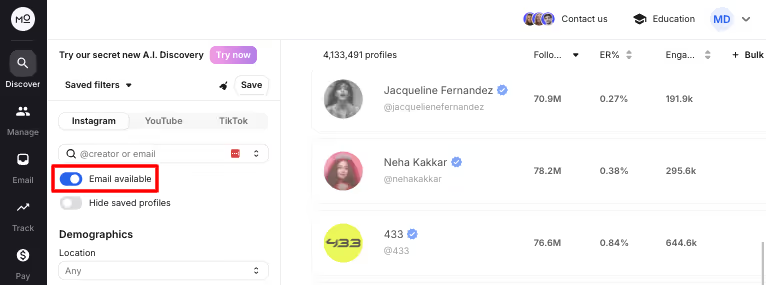
Alternatively, if you already have a list of influencers, you can get an instant view of all their publicly available email addresses. Or, for those with private addresses, just click Unlock all and let Modash find their details for you.
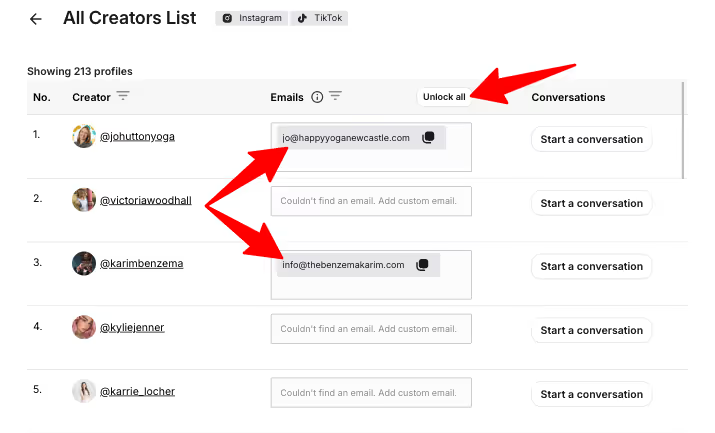
Why waste hours scraping through hundreds of influencer profiles to find emails you could’ve found in a few clicks?
2. Automate outreach follow-ups
When it comes to crafting your initial influencer outreach message to a new creator, you’ll definitely want to add a healthy dose of manual personalization alongside any standard, templated elements (more on that later).
But following up is a different story. The main goal of a follow-up email is to nudge the influencer into reading your first email – and getting there doesn’t necessarily require additional customization.
Sarah Saffari takes this approach:
If you really want to partner with an influencer but they did not reply to your initial outreach message, it doesn’t hurt to customize your follow-ups, too.
But in general, you can save time and effort by setting up an email sequence to follow up with influencers automatically.
3. Automate influencer onboarding tasks
Once you’ve had your discovery call, the work has only just begun. Fortunately, onboarding tasks like signing contracts and sending influencer briefs can be automated. Simply create instructions and a step-by-step workflow in advance, and plug them into an influencer management tool (if you use one) to go out automatically.
Nycole Hampton automates influencer onboarding as the Senior Director of Marketing at her price comparison company.
Of course, you will have to create different briefs for different types of influencer collaborations, but you can at least templatize some generic brand information for that process and only alter campaign-specific details.
Automating influencer onboarding not only saves you time but also avoids delays from the creator’s side. It’s easy to let tasks fall through the cracks when you’re manually sending billing information, brand details, contracts, etc. – but if you’ve set up an automated funnel, the process is seamless.
4. Automate answering FAQs
If you’re running an influencer program, you’ll likely get bombarded with questions. Maybe influencers DM you to ask if you’re looking for creator partners, or maybe you get a ton of inquiries via your ambassador landing page.
Fortunately, you have plenty of options when it comes to answering FAQs at scale:
- Include FAQ sections on your landing page and in your influencer briefs.
- Set up an automated chatbot using tools like ManyChat or ChatBot.
- Set up FAQs and auto-replies in your Instagram DMs.
- Or, keep things simple and create templates for the most common questions.
Either way, automating the answers to FAQs will help you save time and avoid retyping the same messages over and over.
5. Automate tracking live influencer content
So much for managing your influencer pool. What about managing campaigns?
One of the most time-consuming tasks of campaigns is collating live influencer content in one place. When just starting out, you can track this information without any extra tools or automation – you just need a handy master spreadsheet, like this one from Modash (it’s free!).
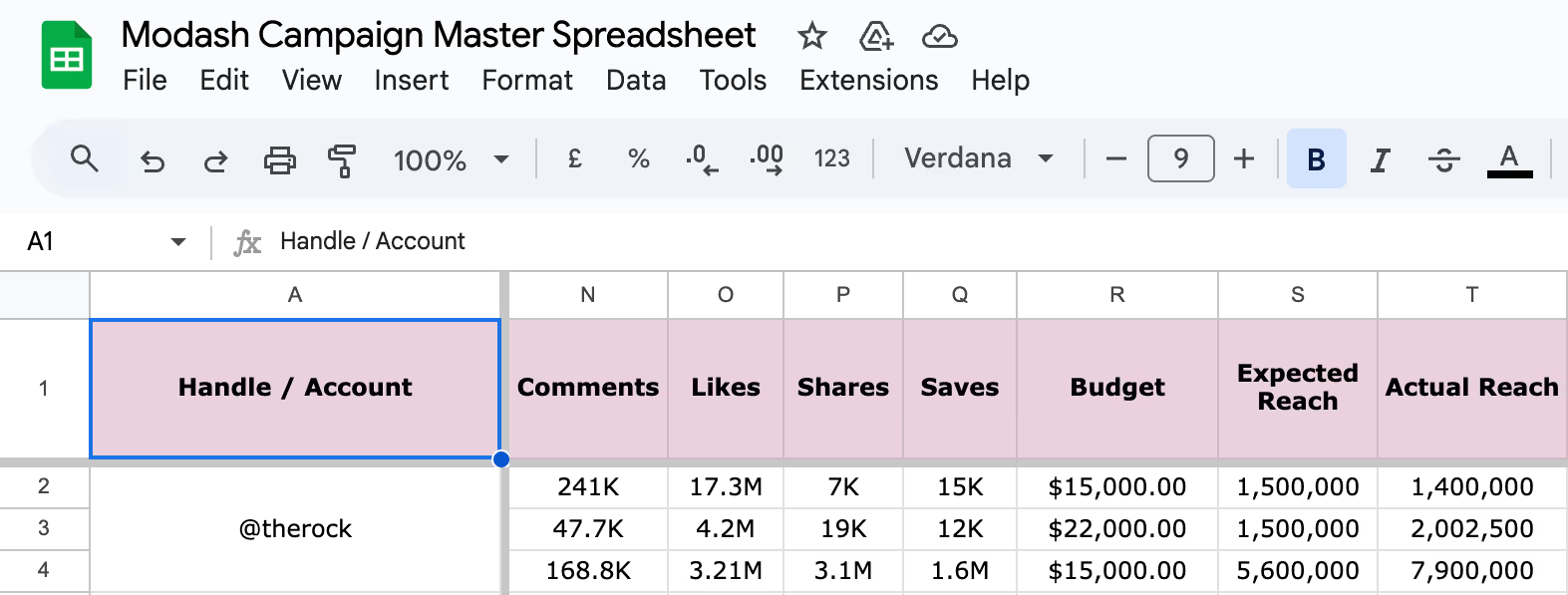
Still, sooner or later, you’re going to outgrow manual tracking.
At that point, you’ll want to start automating the process using influencer tracking tools like Modash. With Modash, all you have to do is:
1. Name your campaign.
2. Specify which influencers you’d like to track.
3. Specify which content of theirs you’d like to track, e.g., posts containing particular hashtags or keywords. (Alternatively, just track all their content.)
4. And voilà! Modash will automatically pull all the relevant content – including Stories – into one dashboard with no need to ask influencers for authentication.
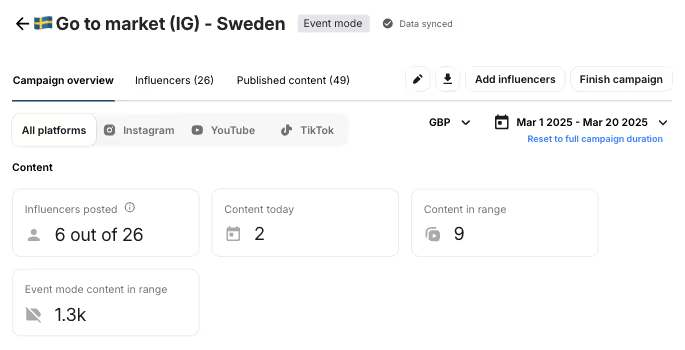
Modash will also give you an overview of how your campaign is performing, thanks to individual influencer performance metrics like:
- Number of posts by each influencer (so you can easily check if they’ve published their deliverables)
- Total engagements and average ER% of your sponsored posts per influencer
- Total revenue (if you connect your Shopify store to track promo codes)
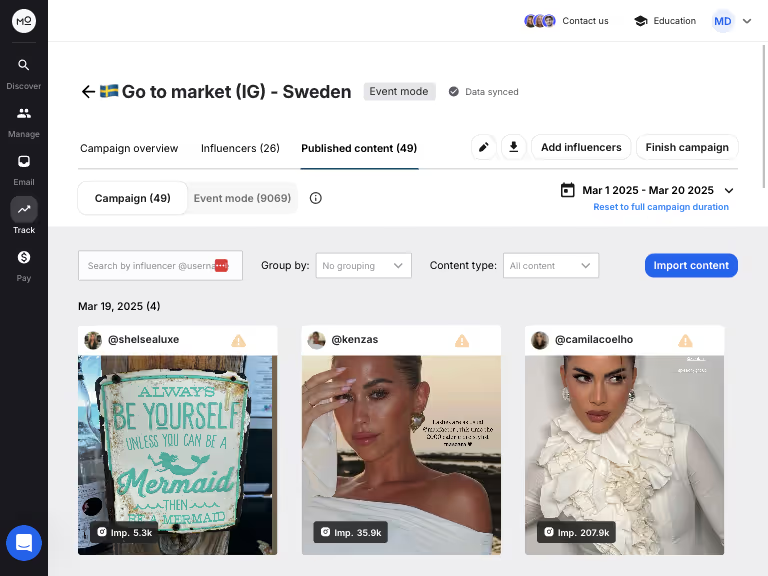
👉 Don’t take my word for it – see it all for yourself by trying Modash for free for 14 days.
6. Automate influencer performance analytics
If you’re using influencer and affiliate marketing together or running performance-based campaigns, you’ll likely need to generate UTM links or coupon codes for each influencer/affiliate. That way, you know exactly where your clicks and sales are coming from.
Again, setting this up manually is a seriously heavy lift. Plus, it’s super boring 😴 So why not automate it?
With Modash, you can:
- Instantly generate unique discount codes for individual influencers
- Set the desired discount value and whether it applies to certain products or the whole order
- Limit the code to one use per customer and/or a certain number of total uses

Plus, you can quickly create unique UTM links in Modash, complete with automatically generated short links – just activate the toggle marked Generate unique back-half:
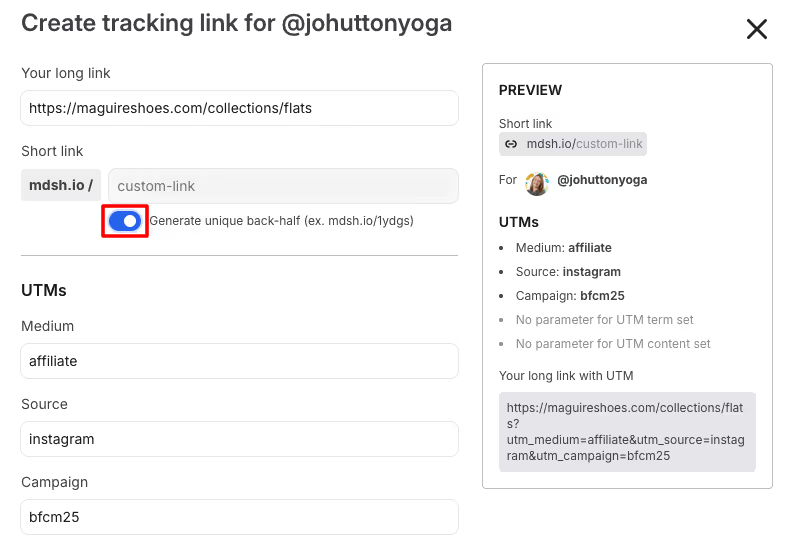
Teri Simone agrees that this part of the influencer marketing workflow should definitely be automated.
Once you’ve set up tracking in Modash, it will automatically pull in all your key campaign data.
For instance, with our Shopify integration, you can view key ecommerce metrics like:
- Total discount code usage
- Total sales
- Total revenue
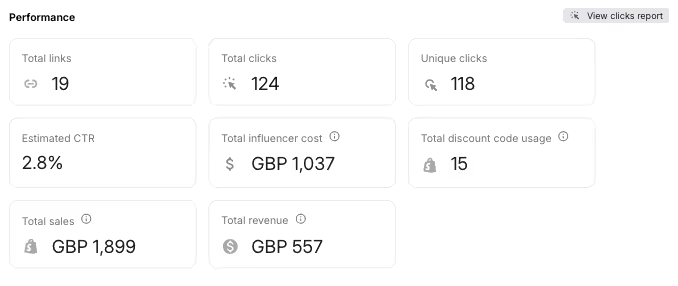
You can also dig deeper into performance by ranking your influencer partners by total sales generated, making it quick and easy to decide which influencers to keep in mind for future collaborations.

The cherry on top? Getting individual and collective performance analytics also helps you ace your influencer marketing reporting without requiring a ton of manual monitoring and data entry.
The 5 things you *shouldn't* automate
1. Don’t automate initial outreach messages
As I mentioned above, your initial outreach messages can evolve from a template, but you shouldn’t fully automate them. Why?
The only way to automate that message is by sending a generic compliment along with your brand details and a call-to-action. Copying and pasting the same message to each influencer won’t generate as high a response rate as sending a personalized message.
Rugile Paleviciute acknowledges that there’s a point when mass outreach would make sense for your marketing strategy – but that personalized messages will always outperform generic ones.
In our outreach survey of 51 marketers, 54% only templatized part of their initial outreach messages. Ideally, you’d personalize the first half of your email followed by templatized details about your company and campaign, like in this outreach example:

❗Exception: You might consider a fully templatized outreach message when you’re a household name that every influencer would be excited to work with. In that case, your response rates are likely to remain high simply due to brand recognition.
Nikola Sokolov also suggests introducing automation in influencer outreach when you’re getting excellent response rates, or when your criteria for right-fit creators is very broad.
2. Don’t automate influencer negotiation
Discovery calls help you start influencer relationships on the right foot and build a strong rapport with your creator partners. There’s just something more friendly about putting a face to a name when you “see” someone – even if it’s on a Zoom call.
When building relationships via email alone, Teri Simone warns that you’ll miss out on improving your overall influencer marketing ROI:
Having a 1:1 call can also help you understand the creator’s strengths beyond past performance metrics. And this extends to influencer negotiations: when you have the influencer in front of you, it’s easier to assess the value they bring to the table, which can potentially help you close a better deal than if you’d been communicating solely via email.
❗Exception: If you’ve created a brand ambassador program that’s self-serving, or you’re recruiting thousands of influencers, you can’t have a discovery call with every single influencer. In that case, it makes more sense to limit communication to email, but you might still consider getting on calls with the highest-value ambassadors.
3. Don’t automate sending offers to collaborate
Build custom offers for the influencer partners you’re collaborating with.
Nycole Hampton says that mass callouts with cookie-cutter offers, campaign details, and pricing feel inauthentic.
Internally, you probably have a ceiling on your budget and a rough estimate of the deliverables you need. But you should still tailor your offer to fit each creator’s strengths and style.
For example, if you find Influencer #1 makes better Reels and Influencer #2 excels at Instagram Stories, pitch the respective content formats when making them an offer. It’ll help them feel like they can be successful in their role and help you make use of the influencer’s forte.
Dmitri Cherner agrees.
(Unless, perhaps, your goals are a certain number of mentions.)
There might be other exceptions. For example, if you’re recruiting for an affiliate program, your offer might be fixed. Even so, making an effort to personalize your messages never hurts.
4. Don’t automate relationship-building activities
Some things need emotional investment and a personal touch, not tech and automation. You can’t automate crafting a personalized greeting or writing a custom thank-you note. Only someone who’s been in the field with the influencer can do those jobs well.
So, avoid automating relationship-building activities – whether it’s running an influencer newsletter or gifting extra merch to top performers. A creator should feel special, valued, and noticed, not like just another cog in the revenue-generating machine.
❗Exception: If you recruit hundreds or thousands of ambassadors, speaking to each of them individually would be impossible. In that case, you can either automate all of your relationship-building activities, or reserve 1:1 comms for top performers.
5. Don’t automate sharing influencer feedback
Providing regular feedback to influencers is crucial – it helps them understand what’s working and what they can do better, and it enables you to specify who is a top performer and what you can optimize for your upcoming influencer collaborations.
Automating this process means an influencer’s performance metrics are sent to them weekly or monthly. But naturally, it lacks the personal touch that can lead to compound growth.
For example, a tool can tell the influencer that their first video performed much better than their second one. But only you can tell them why it was so – maybe audience fatigue had set in, or perhaps their messaging wasn’t on point.
In order to provide personalized feedback, you have to do it manually, and that means you have to invest in resources to assess each influencer’s performance. But it’s time well spent: you help the influencer get the full context on their performance so they can improve.
❗Exception: You might want to skip personalized influencer feedback sessions for short-term creator partners. It’s unlikely your brand will get a return on that time and energy you invest if you don’t intend to collaborate again in the future. For that reason, personalized feedback is best reserved for long-term influencer partnerships.
When should you start thinking about automation? 🤔
While it’s tempting to start automating elements of your influencer strategy from Day 1, that doesn’t mean you should.
If you’re just starting out in influencer marketing, it’s better to do things manually in order to develop your knowledge and skills. For instance, while you can automate influencer onboarding right away, doing it manually the first few times will teach you what creators actually need from you and what questions they have so that you can experiment with the ideal workflow.
Influencer marketing is ultimately a relationship-based skill. Some aspects – like developing a personal rapport with influencers – will always need a human touch, not tools and automations. Automating the wrong tasks might actually damage your influencer relationships, thereby harming your results 📉
Here are your action steps:
1. Think through the processes you must follow for each and every influencer.
2. Cut out the parts that help you build stronger relationships with influencers – you’ll keep doing these tasks manually.
3. Evaluate whether you can use tools to automate the remaining tasks (or at least part of them).
4. Regularly audit your automations to ensure they are working smoothly.
Here’s my parting advice: Don’t sweat it!
Influencer automation is a reversible decision. You can always go back to manual if you automate a task and feel it’s compromising your influencer relationships. Ultimately, trial and error will help you find the right balance.
And if you’re thinking you need a tool to help you get started – you can always try Modash completely free. From finding influencers, to hiring, managing, tracking, and paying them, Modash brings your workflow into a single tab. But don’t take my word for it – try Modash free for 14 days!


